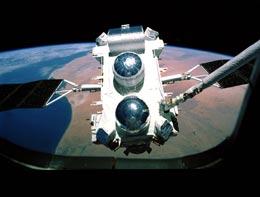Compton Gamma Ray Observatory equipment helps to sniff out radioactive sources.
 Remnants of the Compton Gamma Ray Observatory (pictured), are being used in other fields.NASA
Remnants of the Compton Gamma Ray Observatory (pictured), are being used in other fields.NASAThe 9-year mission of NASA’s Compton Gamma Ray Observatory ended in 2000 with a plunge into the Pacific Ocean. But its spare parts are living on — as a detector of dirty bombs.
James Ryan, an astrophysicist at the University of New Hampshire in Durham, has recycled parts from one of the space telescope’s old instruments, realizing that they can work just as well pointing horizontally as they did vertically up into the heavens.
The telescope once spotted gamma rays streaming from radioactive elements in the sky. Now its technology is being used to detect gamma rays emitted by radioactive substances, such as plutonium, uranium and caesium, which could be used in dirty bombs combining conventional explosives with radioactive material.
“If we can detect aluminum 26 on the other side of the galaxy, we can detect this stuff on the other side of the street,” says Ryan, who will present results from a prototype detector on Monday in Boston at a conference sponsored by the Institute of Electrical and Electronics Engineers and the US Department of Homeland Security.
Getting warmer
There are many techniques for spotting radioactive materials. Some sensors pick up neutrons spat out by radioactive atoms. This technique is very sensitive — neutrons cannot be shielded by lead or concrete walls — but somewhat non-discriminatory.
Gamma rays, although they can be shielded, are emitted with specific energies depending on their parent nuclei, thus providing a potential fingerprint of the radioactive material (although it can still be difficult to tell one thing from another, including, bizarrely, cat litter and uranium; see 'The quest for a finer gamma ray detector').
Many commercial gamma-ray detectors, however, can’t detect the direction of a source. Directionality is particularly useful, for example, if scanning rows of shipping containers rather than single trucks at border crossings, or when tracking a dirty bomb. Ryan recalls watching a US National Guard field exercise in Cape Cod, Massachusetts, as the soldiers struggled to track down a radioactive source in a building, as if they were playing a game of Hot and Cold. “I said, ‘Good grief, that’s a piece of cake. I can spot that a block away’,” Ryan says.
He went back to his lab and dusted off the spare instruments from the Compton Observatory that he had kept since its launch.
Pinpointing the source
The Compton device detects light emitted by electron scattering, caused by gamma rays hitting two layers in the instrument. These two detections allow a user to track the direction of the incoming rays. Ryan says that, from a distance of 10 metres, he can pinpoint a source like caesium to within a third of a metre from side-to-side.
“It’ll work, but it’s not optimal, given the fact it’s so dated,” says Nick Mascarenhas, a physicist at Sandia National Laboratory in Livermore, California, who is building his own directional radiation detector. “It’s probably going to have limitations.”
Even if the nearly 20-year-old Compton telescope technology isn’t the best available kit to turn into a commercial bomb-sniffing tool, homeland security is certainly benefiting by learning from, or borrowing, astrophysical tools that can 'image' the location of radioactive sources, rather than just detecting their presence. “We’re showing that imaging has very powerful advantages,” says Mascarenhas.
Trickle down
Mascarenhas is building a neutron detector that also relies on an astrophysical device — a detector that was first flown in high-altitude balloons to look for neutrons coming from the Sun. It also has directional capabilities, which makes it easier to filter out background radiation - whether from trace uranium and thorium in rock in the ground, or background radiation in the sky. The signal of interest can thus be isolated in a shorter amount of time, he says.
Steve Ahlen, an astrophysicist a Boston University in Massachusetts, says that it is natural that approaches in high-energy physics and astrophysics trickle down into security applications.
Ahlen himself is working on a 30-centimetre cube full of carbon tetrafluoride gas, originally designed to seek elusive dark-matter particles. He realized that by adding helium, his cube could also hunt for neutrons. Now he’s getting funding from the Department of Homeland Security, for a device with two applications: “I really believe it’s the world’s best neutron detector,” he says.



No comments:
Post a Comment